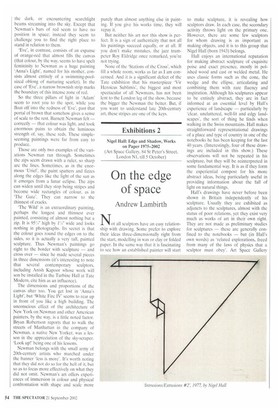On the edge of space
Andrew Lambirth
Not all sculptors have an easy relationship with drawing. Some prefer to explore their ideas three-dimensionally right from the start, modelling in wax or clay or folded paper. In the same way that it is fascinating to see how an established painter will start
to make sculpture, it is revealing how sculptors draw. In each case, the secondary activity throws light on the primary one. However, there are some few sculptors for whom drawing is as important as making objects, and it is to this group that Nigel Hall (born 1943) belongs.
Hall enjoys an international reputation for making abstract sculpture of exquisite poise and exact presence, mostly in polished wood and cast or welded metal, He uses classic forms such as the cone, the wedge and the ellipse, articulating and combining them with rare fluency and inspiration. Although his sculptures appear to be entirely abstract, they are in fact informed at an essential level by Hall's experience of landscape — particularly by 'clear, uncluttered, well-lit and edgy landscapes', the sort of thing he finds when walking in the Swiss mountains. Hall makes straightforward representational drawings of a place and type of country in one of the notebooks he has been keeping for the last 40 years. (Interestingly, four of these drawings are included in this show.) These observations will not be repeated in his sculpture, but they will be reinterpreted in some fundamental way. It is as if they form the experiential compost for his more abstract ideas, being particularly useful in providing information about the fall of light on natural things.
Hall's drawings have never before been shown in Britain independently of his sculpture. Usually they are exhibited as adjuncts to the sculptures, almost with the status of poor relations, yet they exist very much as works of art in their own right. They are not made as preliminary studies for sculptures — these are generally confined to the notebooks — but (in Hall's own words) as 'related explorations, freed from many of the laws of physics that a sculptor must obey'. Art Space Gallery should be congratulated on mounting this beautiful exhibition, and for drawing our attention to a crucial aspect of this very considerable artist's output. (Typically, the quality of Hall's drawings was first recognised abroad, with exhibitions devoted to them in Gothenburg, Sweden in 1975, and in the galleries of the New York Studio School in 1998. Why does proper recognition often come so late in one's homeland?) There are some 25 drawings on show, varying widely in size and media, using charcoal most often, but also employing gouache, pastel, and pencil and wash. All evince an immensely satisfying precision of image, without in any way being fussy. In fact. I can imagine one or two viewers even wanting to 'clean up' a Hall charcoal drawing, removing some of the more obvious smudges and rubbings, as if the artist had been first messy and then forgetful. Actually, every mark, every drift of charcoal dust, and every whole or partial erasure, is entirely necessary. To alter an image by a fraction would be to destroy its secret harmony: 'Take but degree away, untune that string,/And, hark what discord follows.'
In some of these drawings, Hall has used colour to great effect, as indeed he does in some of his sculptures, effectively disproving the typical painter's assertion that no sculptor really understands colour. Hall uses colour spatially, not descriptively or decoratively, but to illuminate the space in which his forms exist. Whether free-standing or mounted on a wall. Hall's sculptures occupy and define a particular space, and tell you new things about line and volume and context. Good sculpture transforms the place in which it is located.
The same can be said of these drawings, for they open up spaces beyond the picture plane. Look at 'Seventeen Triangles', a complex systems drawing focused on a triangle, a quadrant and logarithms. It looks like an obscured light source emerging through the different densities of skilfully manipulated charcoal dust. Or the strange totemic bracket shapes of 'Drawing No. 810', originally based on some naturalistic drawings of cacti, but here crossing a threshold into deep space. Or the seemingly perfect inside/outside movement of Intrusions/Extrusions #2', stated with such poignant clarity and apparent simplicity. I can't do better than quote Hall again: 'Drawing is seeing, thinking, finding, recording, connecting, stilling and distilling. I believe early experience of carving in stone influenced my way of seeing and my way of making drawings and sculpture. A chisel cut will, at one and the same time, make a mark in space, an edge and a shadow.'
Nigel Hall's zinging lines hover in space, turning with the curve of the world, identifying its underlying geometry whilst evoking brilliantly the music of the spheres.











































































 Previous page
Previous page